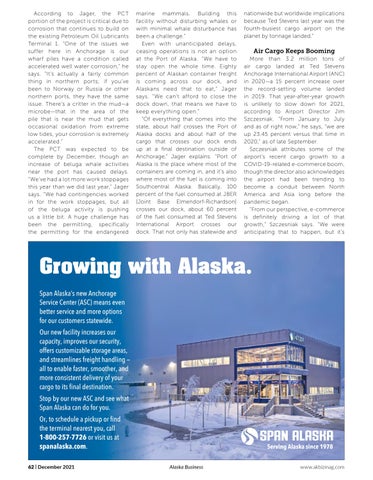According to Jager, the PCT portion of the project is critical due to corrosion that continues to build on the existing Petroleum Oil Lubricants Terminal 1. “One of the issues we suffer here in Anchorage is our wharf piles have a condition called accelerated well water corrosion,” he says. “It’s actually a fairly common thing in northern ports; if you’ve been to Norway or Russia or other northern ports, they have the same issue. There’s a critter in the mud—a microbe—that in the area of the pile that is near the mud that gets occasional oxidation from extreme low tides, your corrosion is extremely accelerated.” The PCT was expected to be complete by December, though an increase of beluga whale activities near the port has caused delays. “We’ve had a lot more work stoppages this year than we did last year,” Jager says. “We had contingencies worked in for the work stoppages, but all of the beluga activity is pushing us a little bit. A huge challenge has been the permitting, specifically the permitting for the endangered
marine mammals. Building this facility without disturbing whales or with minimal whale disturbance has been a challenge.” Even with unanticipated delays, ceasing operations is not an option at the Port of Alaska. “We have to stay open the whole time. Eighty percent of Alaskan container freight is coming across our dock, and Alaskans need that to eat,” Jager says. “We can’t afford to close the dock down, that means we have to keep everything open.” “Of everything that comes into the state, about half crosses the Port of Alaska docks and about half of the cargo that crosses our dock ends up at a final destination outside of Anchorage,” Jager explains. “Port of Alaska is the place where most of the containers are coming in, and it’s also where most of the fuel is coming into Southcentral Alaska. Basically, 100 percent of the fuel consumed at JBER [Joint Base Elmendorf-Richardson] crosses our dock, about 60 percent of the fuel consumed at Ted Stevens International Airport crosses our dock. That not only has statewide and
nationwide but worldwide implications because Ted Stevens last year was the fourth-busiest cargo airport on the planet by tonnage landed.”
Air Cargo Keeps Booming More than 3.2 million tons of air cargo landed at Ted Stevens Anchorage International Airport (ANC) in 2020—a 15 percent increase over the record-setting volume landed in 2019. That year-after-year growth is unlikely to slow down for 2021, according to Airport Director Jim Szczesniak. “From January to July and as of right now,” he says, “we are up 23.45 percent versus that time in 2020,” as of late September. Szczesniak attributes some of the airport’s recent cargo growth to a COVID-19-related e-commerce boom, though the director also acknowledges the airport had been trending to become a conduit between North America and Asia long before the pandemic began. “From our perspective, e-commerce is definitely driving a lot of that growth,” Szczesniak says. “We were anticipating that to happen, but it’s
Growing with Alaska. Span Alaska’s new Anchorage Service Center (ASC) means even better service and more options for our customers statewide. Our new facility increases our capacity, improves our security, offers customizable storage areas, and streamlines freight handling — all to enable faster, smoother, and more consistent delivery of your cargo to its final destination. Stop by our new ASC and see what Span Alaska can do for you. Or, to schedule a pickup or find the terminal nearest you, call 1-800-257-7726 or visit us at spanalaska.com. 62 | December 2021
Serving Alaska since 1978 Alaska Business www.akbizmag.com












